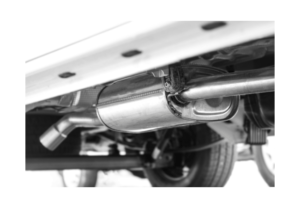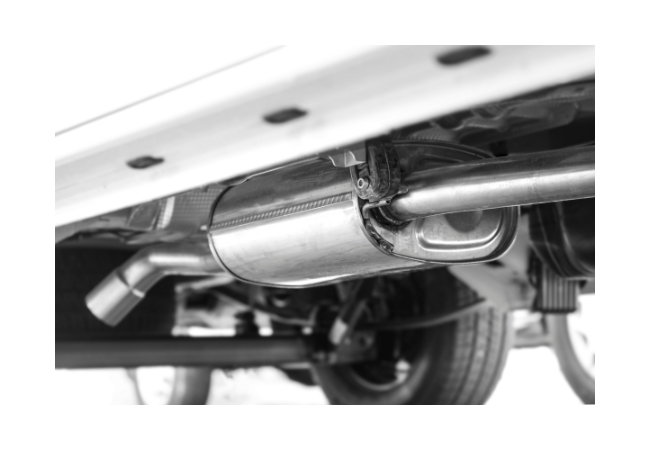An exhaust resonator is a component found in the exhaust system of an automobile. Its primary function is to reduce the noise produced by the engine and exhaust system. It does this by creating a series of sound waves that cancel out or “resonate” with the noise produced by the engine. The resonator works by creating a chamber that allows for the refraction and reflection of sound waves, which reduces their amplitude and frequency. This article will define what is an exhaust resonator and the difference between an exhaust muffler and a resonator.
The importance of an exhaust resonator cannot be overstated since it plays a crucial role in reducing the amount of noise produced by an automobile’s engine and exhaust system. Without it, drivers would be subjected to loud noises that could cause hearing damage or discomfort. Additionally, many localities have noise ordinances that restrict how loud vehicles can be, making it essential for cars to have properly functioning resonators.
An exhaust resonator is a critical component found in automobiles’ exhaust systems, responsible for reducing engine and exhaust noise. Its operation involves creating sound waves that resonate with those from the engine, effectively reducing their amplitude and frequency. The importance of having a properly functioning resonator cannot be overstated since it helps prevent hearing damage and ensures compliance with local regulations on vehicle noise levels while providing a smoother ride for drivers and passengers alike.
Jump to
Definition of an Exhaust Resonator

An exhaust resonator is a component found in a vehicle’s exhaust system that serves to reduce the noise produced by the engine and exhaust. Its primary purpose is to create a series of sound waves that cancel out or “resonate” with the noise produced by the engine, thereby reducing its volume. The resonator works by creating a chamber that allows for the reflection and refraction of sound waves, which reduces their amplitude and frequency.
The exhaust resonator works by taking advantage of the principles of soundwave resonance. When soundwaves travel through a hollow chamber, they can reflect back on themselves, creating interference patterns that either amplify or cancel out certain frequencies. In the case of an exhaust resonator, it is designed to produce specific frequencies that will resonate with those produced by the engine and muffler, effectively reducing their volume.
There are several types of resonators available on the market today, each with its own unique design and set of features. One common type is called a Helmholtz resonator, which uses a small opening to let air in and out at specific frequencies to create resonance. Another type is called a quarter-wave tube resonator, which creates resonance by using a tube with one end closed off. Finally, there are also straight-through or “glass pack” style resonators that use fiberglass packing material to absorb sound waves.
An exhaust resonator’s purpose is to reduce the noise produced by an automobile’s engine and exhaust system. It does this by creating specific frequencies that resonate with those generated by the engine and muffler while reducing their amplitude and frequency. There are several types of resonators available on the market today, each using different designs and materials to achieve their desired effect.
Design and Construction of an Exhaust Resonator
The materials used to make exhaust resonators vary depending on the type and application of the component. Common materials include stainless steel, titanium, aluminum, and various types of composites. These materials are chosen for their durability, resistance to corrosion, and ability to withstand high temperatures.
The design of an exhaust resonator is crucial in determining its effectiveness in reducing engine noise. Factors such as the size and shape of the chamber, the placement of inlet and outlet ports, and the use of sound-absorbing materials all play a role in how well it functions. Additionally, factors such as engine displacement, exhaust flow rate, and RPM range must be considered when designing a resonator that will work effectively with a particular vehicle.
The components of an exhaust resonator can vary depending on the specific design. However, most resonators consist of an outer shell made from one or more layers of material such as stainless steel or composite. Inside this shell is a perforated tube that allows exhaust gasses to flow through while also producing sound waves that create resonance within the chamber. Finally, some designs may include additional sound-absorbing materials such as fiberglass packing or ceramic wool to further reduce noise levels.
The materials used to make an exhaust resonator depend on its specific application and desired characteristics. The design factors that must be considered when creating a resonator include size and shape considerations as well as engine specifications like displacement and RPM range. The components found inside most resonators usually consist of an outer shell enclosing a perforated tube that produces resonance while allowing for proper gas flow through the system.
The Impact of Exhaust Resonators on Sound
Exhaust resonators work by producing specific sound waves that are designed to cancel out or “resonate” with the noise produced by the engine and exhaust system. This is achieved through a series of chambers and ports within the resonator that allows for the reflection and refraction of sound waves. The result is a reduction in overall noise levels, particularly at certain frequencies where the resonator is most effective.
Differences Between Mufflers and Resonators
While both mufflers and resonators serve to reduce exhaust noise, they do so in different ways. Mufflers work by using a series of baffles or chambers to reflect and absorb sound waves before they exit the tailpipe. In contrast, resonators use specific sound wave frequencies to create resonance within the exhaust system that cancels out unwanted noise. Additionally, mufflers are often larger than resonators due to their more complex design.
The addition of an exhaust resonator can have both positive and negative effects on engine performance. On one hand, reducing exhaust noise can allow drivers to hear other important sounds such as traffic or emergency vehicles while driving. Additionally, some high-performance vehicles may benefit from increased backpressure caused by adding a resonator to their exhaust system. However, adding too many restrictions or changes to an engine’s exhaust system can also negatively impact performance by reducing horsepower and torque output.
Exhaust resonators reduce noise levels by producing specific sound waves that cancel out unwanted frequencies within the exhaust system. While similar in function to mufflers, they achieve this goal through different means and have unique effects on engine performance depending on their design and application.
Installation and Maintenance of Exhaust Resonators
Installing an exhaust resonator typically involves cutting out a section of the existing exhaust pipe and welding the resonator in its place. This process can vary depending on the specific make and model of the vehicle, as well as the design of the resonator being installed. It is important to ensure that all connections are secure and leak-free to prevent any issues with exhaust gas leakage.
To keep an exhaust resonator functioning properly, it is important to perform regular maintenance on the entire exhaust system. This includes checking for leaks, rust, or corrosion, and replacing any damaged components as needed. Additionally, cleaning out any debris or buildup inside the resonator can help to maintain its effectiveness at reducing noise levels.
One common issue with exhaust resonators is corrosion or rust caused by exposure to moisture and road salt. If left unchecked, this can lead to holes or other damage that may require the replacement of the entire component. Additionally, if an exhaust resonator becomes clogged with debris or buildup, it may no longer function properly and could lead to increased noise levels or reduced engine performance. In these cases, cleaning or replacement may be necessary.
Proper installation of an exhaust resonator involves securely welding it into place while ensuring all connections are leak-free. Regular maintenance including checking for leaks and cleaning out debris can help prevent common issues such as corrosion or clogging. However, if problems do arise with an exhaust resonator they may require repairs such as cleaning or replacement to maintain proper function and reduce noise levels effectively.
Conclusion
Exhaust resonators are an important component of many vehicles’ exhaust systems that help to reduce noise levels and improve the overall driving experience. They work by producing specific sound waves that cancel out unwanted frequencies within the exhaust system and can be installed in place of a section of the existing exhaust pipe.
Differences between mufflers and resonators were also highlighted in this discussion. While both serve to reduce exhaust noise, they do so in different ways. Mufflers use baffles or chambers to reflect and absorb sound waves, while resonators create resonance within the exhaust system.
Maintenance tips and common issues with exhaust resonators were also discussed. Regular maintenance can help prevent corrosion or clogging issues, while repairs such as cleaning or replacement may be necessary if problems arise.
Exhaust resonators are an important component for reducing noise levels from engine exhaust systems. This is especially true for high-performance vehicles where excessive noise can be a nuisance, or where local regulations require certain decibel levels to be met. Additionally, reduced noise levels can allow drivers to better hear other important sounds while driving
Exhaust resonators play an important role in reducing engine noise levels and improving the overall driving experience. Proper installation and regular maintenance can help prevent common issues such as corrosion or clogging. When considering upgrades to a vehicle’s exhaust system, it is important to weigh the benefits of adding an exhaust resonator against any potential negative impacts on engine performance.

My name is Tom Harris, founder of this blog. I’m a mechanical engineer with 20 years of experience in the automotive industry. I’m here to help you with your vehicle’s problems, easy fixes and share my insights and experience so that you can enjoy your rides more.

